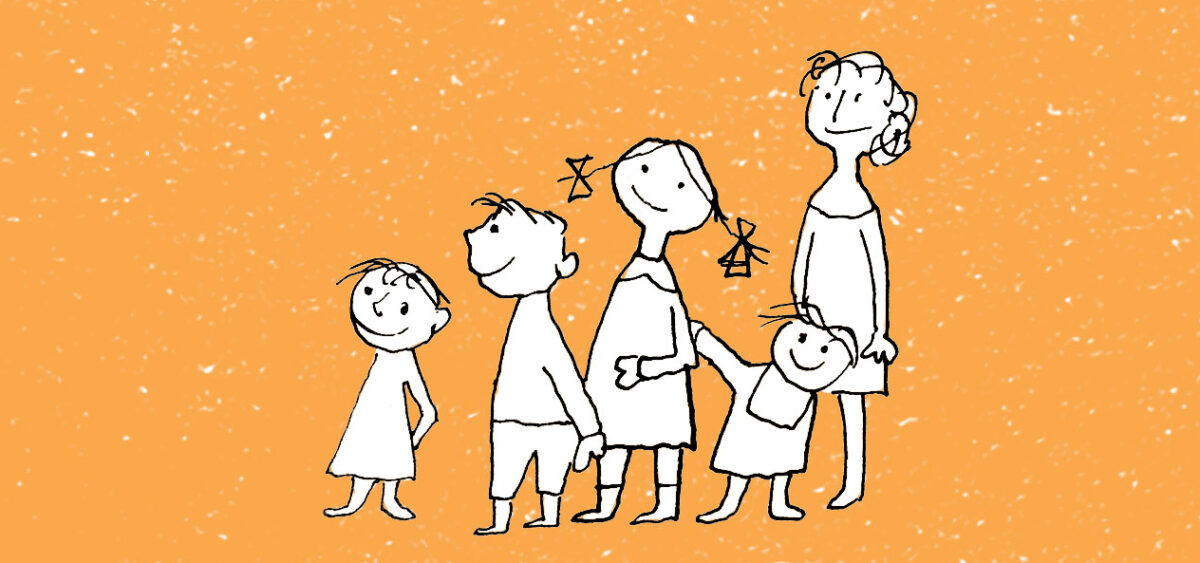
A boy who harnessed the wind, a smiling female warrior, sisters stamping out plastic. How the fearless underaged change the world.
Mona Lisa versus hatred
April 2016, Birmingham. A march is taking place, organized by a far-right organization called the English Defence League (EDL). The Press Association photographer Joe Giddens is there. Before he takes a picture that will soon circle around the world, a Muslim woman, Saira Zafar, is walking down the street and gets surrounded by a dozen or so aggressive men. A teenage girl, Saffiyah Khan, will stand by her. She won’t push the men away, she won’t berate them. But she will make them stop. She will smile.
The girl in Giddens’ photo is wearing a denim jacket, a black hood sticks out from underneath it. She has an earring in her nose. Her 17-year-old face is beaming with a warm smile. You can even see it in the eyes turned towards the man in front of her. It’s Ian Crossland, leader of the EDL. There is a policeman in a helmet between them – his mouth is wide open, he is saying something, perhaps shouting.
Saffiyah catches the eye the way Mona Lisa does, even though she is not even in the centre of the frame. The only female among the crowd of shouting, enraged men. The photo immediately spreads over the internet and Saffiyah is declared a ray of hope for Birmingham and for the world.
“Sometimes it’s more important to smile than shout – and I did a fair bit of shouting, I’m under no illusions about that. But to smile is a more powerful message,” she said in one of the news reports. The photo started an avalanche of enthusiastic comments and invitations, for example to a concert of her favourite ska band, The Specials. She was wearing their T-shirt under her hoodie on that day in Birmingham. Last year they recorded a song together called “10 Commandments”. Saffiyah was also invited to Labour Party meetings. She became a darling of the British left and helped fundraise for Labour’s 2017 electoral campaign. She also appeared in fashion shows. Designer Dilara Findikoglu invited her to portray Lady Justice on the catwalk.
Her presence at that right-wing march was not an accident. Already as a 14-year-old, she had supported anti-racist initiatives. “I was zooming in on what was going on in my community, in my local area, in my town Birmingham, and I was working out what problems there were, and how it was that I was going to apply myself and try to fix them,” she said during her TEDx talk. She got involved for the first time when the opening hours of the Birmingham Central Library were cut down because of budget cuts. The teenager stood in front of the library with a group of protesters. She also took part in meetings with trade unions. Several weeks later the changes were scrapped.
Saffiyah also gets involved with the work of a help centre in Birmingham. As a photographer, she followed children during their project on artistic development. She is active and doesn’t want to stop. She doesn’t identify with the label ‘activist’. According to her, activism is simply a term describing people who are active in their community. And she thinks that everybody should be at least a little bit engaged for the benefit of the place where they live. Her message is an invitation: ‘Be active, not an activist’.
A hunger strike against plastic
In March 2018, British diver Rich Horner went underwater in Manta Point, a popular Indonesian base near Nusa Penida island, just over 20 kilometres from the tourist-paradise Bali. A short film shows him swimming through a tangle of plastic. That recording has stirred the whole world.
In Indonesia, nobody is surprised that the rainy season also brings ‘the garbage season’ to the beaches. The island, like many others, does not have an appropriate waste management or correlating education system. Indonesia, which consists of over 13,000 islands, takes a dishonourable place (second after China) when it comes to polluting oceans with plastic. The country is responsible for 10% of water pollution globally. But that might change. “Welcome to Bali, do you have any plastic to declare?” is a question you can now hear at the airport. In June 2019, the island introduced a total ban on single-use plastics – for example, plastic bags, cutlery, straws. Both producers and consumers can be fined. The island owes this change to two determined teenage girls.
Sisters Melati and Isabel Wijsen attend Green School Bali. This green school is built out of bamboo, located among tropical palms and lit by solar energy. The school’s mission is to educate change-makers – social entrepreneurs who will make the world more balanced. The Wijsen sisters fulfil this mission perfectly. When Melati was 12-years-old and Isabel was 10, they learned about Nelson Mandela and Mahatma Gandhi. “Walking home that day we agreed that we also wanted to be significant. Why should we wait until we were grown up to be significant? We wanted to do something now,” they said in their TED talk.
That day, after school, they sat on the sofa and had a brainstorming session about the problems facing Bali. What worried them the most was plastic waste. They started reading about Hawaii, Rwanda, Oakland and Dublin – places where plastic bags had been banned. They decided to start an NGO, Bye Bye Plastic Bags, to oust plastic bags from the island.
They wrote a petition and aimed to get one million signatures. It went slowly. Somebody suggested that 16 million people come through Bali airport every year, so it might be easier there. But the airport staff just sent them from one department to another. When they finally found themselves in front of the director of advertising, they gave a speech about the island turning into a lost paradise, because of the production of 680 cubic metres of plastic waste every day, less than 5% of which was recycled, most of it ending up in rivers and the ocean. The director allowed them to collect signatures. An hour later, they had 1000. Altogether they collected 100,000 signatures before they sent the petition to the governor of the island. Yet it took him 18 months to find time for them.
In the meantime, the sisters went to India as representatives of Bye Bye Plastic Bags. Their parents took them to visit Gandhi’s house. “By the end of the tour […] we both made a decision and said, ‘We’re going on a hunger strike.’” Just 24 hours after starting the strike, a car pulled up in front of their house and they were taken to the Bali governor’s office. He promised to help get rid of plastic bags from the island by January 2018.
But the sisters didn’t stop there. They organized regular cleaning of beaches from plastic (12,000 volunteers participated in this action); they got thousands of children from across the island involved. They held meetings in schools about the problem of plastic, promoted plastic-free shops and hotels, granting those places a badge: ‘One Island, One Voice’. “Isabel and I were only ten and twelve years old when we stared this. We never had a business plan, nor a fixed strategy, nor any hidden agendas, just the idea in front of us,” Melati recalled during their TED talk. “Kids have a boundless energy and a motivation to be the change the world needs.” Up until today, their idea has inspired young activists in 25 countries – there are anti-plastic coordinators, for example, in Mexico, India, Hong Kong and London.
Plastic bags have not yet been completely eradicated from Bali. But they are not used in supermarkets and retail chains anymore, which now offer canvas bags. Nonetheless, plastic still rules on street markets. The Wijsen sisters are 17 and 15 years old today. They have gained enormous experience. As they say themselves, they have learned to be patient, diligent; how to collaborate, start friendships. They think that the voice of the young generation should matter more. “If we could meet with world leaders and speak to them, we would tell them to listen more to the youth, consider us as more than just inspiration,” they said in an interview with CNN. “We have bright innovative ideas of how to deal with some of the greatest issues of our time. We are the future, but we are here now, and we’re ready.”
Wind blows poverty away
A TEDx conference is underway in Arusha, in north-western Tanzania. It’s 2007. A 19-year-old boy in a white shirt takes the stage. His throat is tight with nerves and he barely manages to give curt answers to the questions asked by the host. The day before, the boy was onboard a plane for the first time in his life. The previous evening was his first spent in a hotel. He had never before used a computer or the internet. He had never been surrounded by so many white people. When they clap, he looks at them with alarm.
William Kamkwamba is on this stage because, at the age of 14, he harnessed the wind. He is from Masitala, a rural village 2.5 hours drive away from the capital of Malawi, Lilongwe. His parents, like other people in the area, grew maize. They lived in a simple house, got water from a well, their light source was a paraffin lamp. William is their only son, but they also have as many as six daughters. He always liked going to school, but when he was about to finish primary school, a great drought set in, bringing famine to the whole region. Malawians were dying. William’s family ate once a day, only in the evening. Each person was allowed to have three handfuls of nsima, maize porridge. They couldn’t afford the fees for their son’s secondary school, which were $80 per year.
”We dropped down to nothing,” William recalls in another TED talk, two years after the first one. “I looked at my father and looked at those dry fields. It was the future I couldn’t accept.” Determined to get education, he started going to the library in his old primary school. He was most interested in physics textbooks. He didn’t know English very well; he learnt many words from diagrams and drawings. An American textbook Using Energy fell into his hands, with an image of a windmill on the cover. That was how William found out that a windmill can also pump water and produce electricity, which was the solution to his family’s problems.
He found the materials in a scrapyard – an old bicycle frame and a dynamo, which became the basis of the machine, as well as an absorber, a pipe and melted PVC boards, which were to become wings. It took him long months to build the machine. The villagers, as well as his own mother, thought he was crazy.
In the book The Boy Who Harnessed the Wind, which William wrote together with the American journalist Bryan Mealer, he recalls that the night before launching the windmill, he didn’t sleep a wink. “It appeared exactly as I’d seen it in my dreams. News about my work had spread far and wide, and now people began to arrive. The traders in the market had watched it rise from a distance and they’d closed up their shops, while the truck drivers left their vehicles on the road. They’d crossed the valley toward my home, and now they gathered under the machine, looking up in wonder. I recognised their faces. These same men had teased me from the beginning, and still they whispered, even laughed.” His legs shivered, he begged the machine in his head not to let him down. It started and when the dazzling glow of the bulb appeared, somebody shouted: “The boy has done it. He has made electric wind!”
At first his windmill powered one lightbulb, then four. William created a system modelled on an electric doorbell. Neighbours started queuing in front of his house to charge their mobile phones. And soon journalists arrived. The news reached the TED global director, and that was how the flustered boy ended up on the stage in Arusha. When he was asked to give a talk two years later, he was a changed boy. More confident, relaxed, he knew how to tell his story and how to make the audience laugh. He had built a second and third windmill, pumping the water and irrigating the fields of the whole village.
William’s projects got the attention of benefactors, who funded his studies at Dartmouth College in the US. Today, William is 32 and works for the NGO Ideo, which runs aid programmes, for example, reading books to refugee children in Jordan, supporting HIV research in Kenya, and designing sewage systems in India. On top of that, William collaborates with Widernet, which improves remote education, as well as running his own organization, Moving Windmills. Its motto is ‘African solutions to African problems’. He supports and encourages local leaders to get involved in issues that matter to their communities, from supplying running water with the use of solar pumps, through to equipping schools with electricity, to sewing costumes for the village football team Wimbe United.
The windmill changed William’s life. He became a hero. He ended his second professional talk with the following words: “I would like to say something to all the people out there like me, to the Africans, and the poor who are struggling with your dreams. God bless. Maybe one day you will watch this on the internet. I say to you, trust yourself and believe. Whatever happens, don’t give up.”
Translated from the Polish by Anna Błasiak










